Last summer (2012 I’m talking about), there was a day that was somewhat lessened of the stultifying heat and paralyzing humidity, and I made straight for Port Morris, the Bronx, where I had never been. ( I always try to walk at least one street per week where I have never been.) This strictly industrial environ was bereft of human habitation except for the odd bus that was making its route, and I was Belafonte in The World, the Flesh and the Devil before Inger Stevens showed up, and then Mel Ferrer to put his claim on Stevens. I like deserted parts of town — Lord knows I frequent Midtown and its cheek to elbow hornhonk ignominy on a daily basis. I can’t complain about that either. I return home to an empty house; it is the life I have chosen.
In March 2013 I stalked around Mott Haven, the chill wind producing a permanent trickle of tears from my left eye. I was scouting an upcoming ForgottenTour. A secret of FNY is that I typically have hundreds of photos associated with a tour, not only from me taking them, but also from tourgoers. So I always have a backlog of photos to use in case the muse runs dry, or I’m preoccupied with the Terrors, or I’m otherwise too busy to go around shooting anything. FNY is now a self-perpetuating machine.
On this page, I’ll combine photos from both trips, and attempt to write coherent passages describing what I saw.
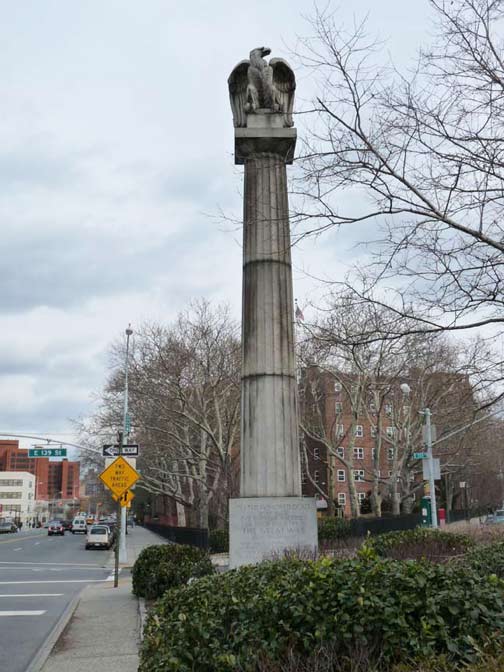
Squeezed in between the Harlem River and Yankee Stadium in the southernmost Bronx is a small neighborhood known as Mott Haven, after Jordan Mott, who built a tremendously successful iron works beginning in 1828 (the iron works continued to 1906), centered along the Harlem River from about Third Avenue to East 138th Street. His handiwork can be still seen all over town on airshaft and manhole covers built by the Mott Iron Works. Mott had bought the original property from Gouverneur Morris II in 1849; Morris was asked if he minded if the area was called Mott Haven, a name it had quickly acquired. “I don’t care…while [Mott] is about it, he might as well change the Harlem River to the Jordan.” The iron works produced practical and ornamental metalwork used worldwide.
In 1850, Mott drew up plans for the lower part of the Mott Haven Canal, which followed an underground stream parallel to Morris Avenue and east of the Harlem River. When completed, it enabled canal boats using the canal to go up as far as 138th Street, encouraging the local industrial development. It has since been filled in. Residential neighborhoods, such as the one which forms the Mott Haven Historic District, are not common in Mott Haven. After 1856, Mott Haven joined with several other villages to form the town of Morrisania, although the area still continues to be known by its original name.
Mott Haven was one of the few areas of the Bronx to attract nineteenth-century speculative developers interested in constructing rowhouses. Much of mis construction occurred following the opening of transit lines connecting this area to Manhattan. With this transit link, Mott Haven became a convenient location drawing middle-class families who sought to purchase single-family rowhouses.
After the New York & Harlem Railroad linked the southeast Bronx to Manhattan in 1840 and Mott built his canal in 1850, Mott Haven began to flourish as an industrial center. Known for its metal works, saw mills, and stone yards, Mott Haven’s industry expanded into the fields of piano factories, lumberyards, furniture manufacturers, and food and ice producers over the course of the nineteenth century. By the early twentieth century, the area had one of the largest concentrations of manufacturing buildings and facilities along the Harlem River.
Development in the district began in 1877, prior to the inception of mass transit, with the construction of three modest rowhouses, designed in the popular neo-Grec style. Most of the buildings in the district, however, were not erected until the 1890s.
GOOGLE MAPS: Mott Haven and Port Morris
Above we see Mott Haven’s World War I memorial.
Graham Square, now called Graham Triangle, is one of the Bronx’ major crossroads as here East 138th Street, Lincoln Avenue, Morris Avenue and Third Avenue all come together. (The Third Avenue el didn’t run above this section of Third Avenue — after crossing the Harlem River, it ran in a right of way between Alexander and Willis Avenues, joining Third Avenue at East 145th Street. North of the Hub at East 149th, the el hung tough until 1973; south of that, it was razed in 1955. The square was named to honor Mott Havener John B. Graham, who perished in World War I. The memorial column, inscribed with others from the area who died in WWI, was sculpted by the Marconi brothers and dedicated in 1921.
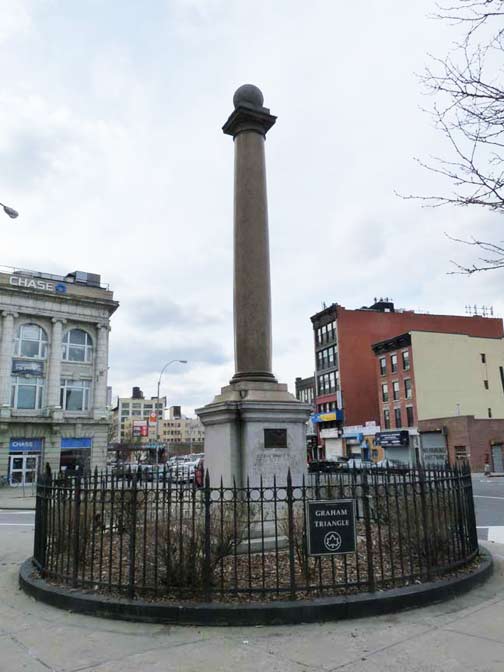
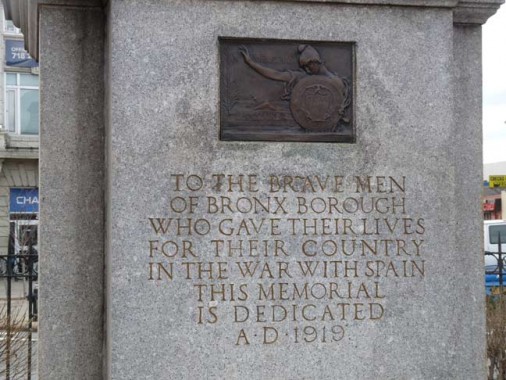
At this remove, the Spanish-American War at the 20th Century’s turn, which skyrocketed Teddy Roosevelt onto the national scene, is little remembered, and may have even been drummed up by the Hearst newspapers, which blamed Spain probably falsely for the destruction of the Maine. There are few Spanish-American War memorials in NYC, but there’s this handsome ball-on-shaft specimen here on the south side of Graham Square.
A column erected in 1919 at Graham Square in the Mott Haven section of the Bronx is dedicated to those from that community who served and died. In 1941, a large granite stele was dedicated to Spanish-American War veterans in Captain George H. Tilly Park in Jamaica, Queens. (Tilly, the son of a prominent Jamaica family, was killed while fighting in the Philippines in 1899.)
By far, the most significant Spanish-American memorial in the city is the grand Maine Monument (1912) at Central Park’s Merchant’s Gate at Columbus Circle, that honors the 258 American sailors who perished when the battleship Maine exploded in the harbor of Havana, Cuba, then under Spanish rule. Soon after, newspaper publisher William Randolph Hearst agitated for war with Spain.
Staten Island’s “Hiker” statue in Tompkinsville honors local soldiers who served in the Spanish-American War. The statue depicts a foot soldier dressed in military fatigues, with a rifle slung over his shoulder. The image (and nickname) is derived from the long marches that the infantry endured in the tropical Cuban climate and terrain.
A Spanish-American War memorial flagpole is also in the center mall at Northern Blvd. and Main Street in Flushing.
By the way, Graham Square in a March wind feels like the Ultima Thule of NYC.
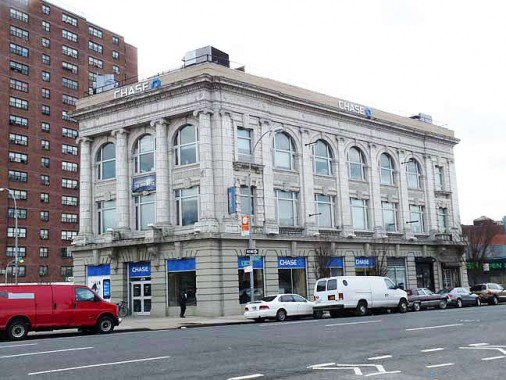
Classic Ionic columns and pilasters (half columns attached to a building front) punctuate this 1912 design by Albert Davis. It’s called the North Side building because Manhattan and the Bronx once formed New York County, and this was north of downtown Manhattan.
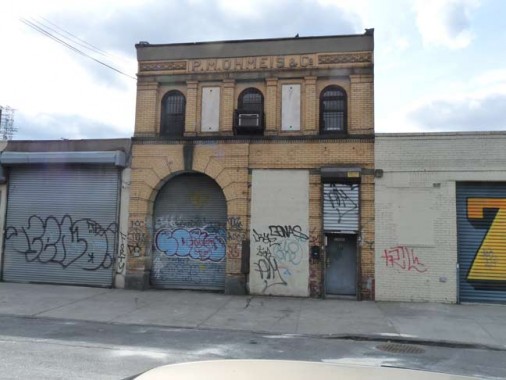
A long-ago office building on East 134th near 3rd Avenue with an arched entrance and windows on the second floor uses yellow-colored bricks more commonly seen in western Queens (Astoria, Ridgewood, Glendale). They may come from the Kreischer brick works in Staten Island, which produced tons of light brown to yellow bricks in the early 20th Century. The original owner, P.M. Ohmeis, is bricked at the roofline. Peter Ohmeis was a beer distributing firm between 1880 and 1906, dealing with Schlitz exclusively.
These little architectural gems are the minuscule repositories of NYC history. The giant Mott ironworks was just across 3rd Avenue from here.
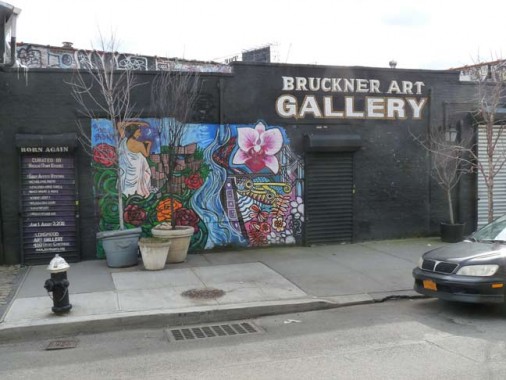
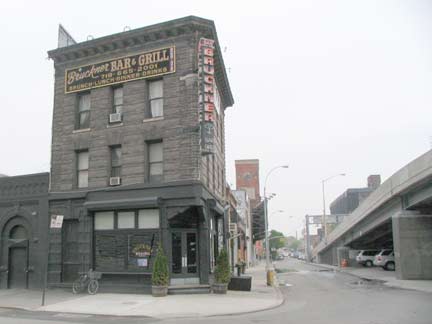
An art gallery up here? You bet. It’s an adjunct to the Bruckner Bar and Grill, #1 Bruckner Boulevard at Third Avenue. In March ’13 I had been hoping to steer the ForgottenTour crowd in here for the post game show, as we’re wont to do, but I found that the place was padlocked after the whole interior had been ruined after being submerged by Hurricane Sandy in October 2012.
Reopening the Bruckner was stalled by ongoing repairs and a management dispute, but it was scheduled to reopen in October ’13 under new ownership.
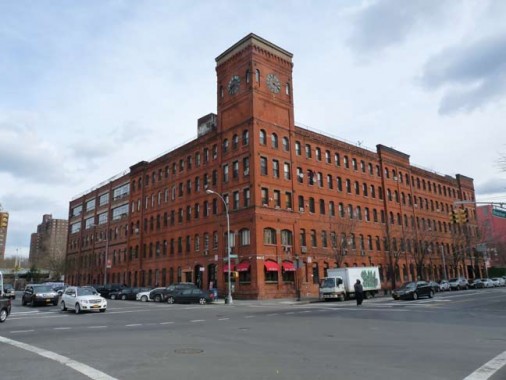
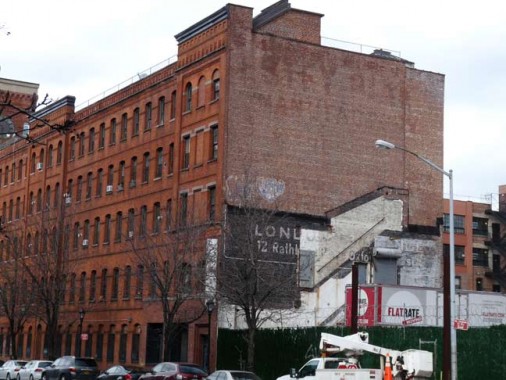
Besides its giant metalworks, Mott Haven gained the reputation in the early 20th Century as NYC’s piano manufacturing capital (despite was the Steinways said about that across the East River in Astoria). The South Bronx was indeed known as “The Piano Capital of the United States” prior to World War I.
For me the most impressive of the old piano works is Estey Piano, with its clock tower at Bruckner Boulevard and Lincoln Avenue.
The Estey Piano & Organ Company was one of the most important players in the late 19th and early 20th Century Piano & Organ manufacturing business. Established in 1846, Estey was one of the few American manufacturers to survive over a century. For decades, Estey manufactured several lines of upright pianos, player pianos and grand pianos. Estey instruments are known far and wide as being exceptionally well made, durable instrument, and they are well worth restoration and preservation today. Production under the Estey name was discontinued sometime in the 1970s. The Antique Piano Shop
Many other piano factories, the Bollermann-Kroger, Haines-Kroger and Krakauer Piano and other, still stand proudly on Bruckner Boulevard and surrounding side streets. It’s time for the Landmarks Preservation Commission to give these great buildings their imprimatur.
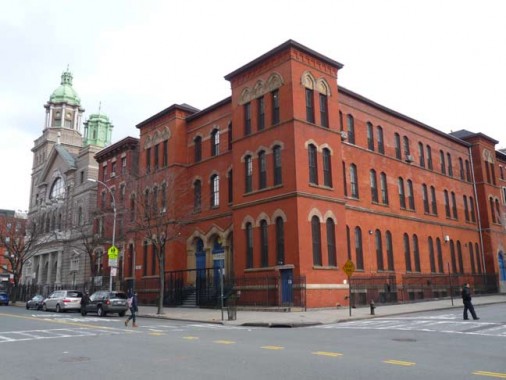
As ForgottenFans might guess from reading this thing for 15 years, I’m very big on stolid brick architecture, but of a certain type, with a certain flair. I especially enjoy factory buildings, with their big brick facades, and appreciate them even more when they’re turned residential. For years I lusted after an apartment in a converted pipe factory complex in Woodhaven across from Forest Park. I moved into a complex of brick buildings surrounding an inner courtyard in Little Neck in 2007 and it’s been like heaven. (The complex, I mean. Little Neck has gone downhill in a handcart lately, with the closing of the Scobee Diner and other neighborhood anchors).
But I stray from the subject at hand. This is actually a school building:
After opening in the late 1800s, Alexander Avenue became known as Doctors Row and “Irish Fifth Avenue.”
The congregation of St. Jerome’s Roman Catholic Church was founded in 1869, and two years later, the present school was erected. This school building was designed in the Victorian Gothic style with two low towers and pointed arch windows. The central triple doorway has handsome stone arches with pointed drip moldings above. The windows at the tops of the towers, with quatrefoils (shaped like 4-leaf clovers) set in pointed arches, reflect the character of the doorway without being identical to it. Along 137th Street, the long side has paired arched windows.
Budgetary problems with the Catholic Diocese forced the school’s closure in June 2013.
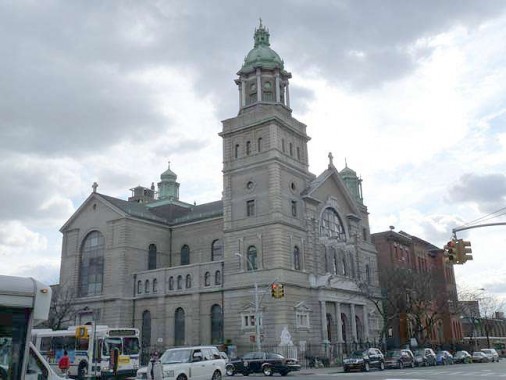
I like this shot of St. Jerome’s Church, at Alexander Avenue and East 138th, because the church and its tower seem to be rebuking the presence of the fiercely clouded March sky.
“In 1898, the congregation at St. Jerome’s built the Church which now stands on the corner of Alexander Avenue and 138th Street. The Church was designed by Dehli & Howard in the style of the Italian Renaissance with features reminiscent of Hispanic antecedents. Although the then primarily Irish congregation could not have possibly foreseen it, the present congregation Is largely Spanish speaking, making the style of architecture particularly appropriate.
Of the two towers, which flank the pedimented center section, the corner tower is appropriately higher and more elaborate. It is surmounted by an octagonal belfry with Tuscan columns and is crowned by bold entablature blocks that, in turn, support an octagonal dome with a delicately detailed lantern. Between the two towers an enormous arched window.”
The church’s beloved longtime pastor until 2008, Rev. John Grange, a longtime supporter of the neighborhood’s immigrants, passed away in October 2013.
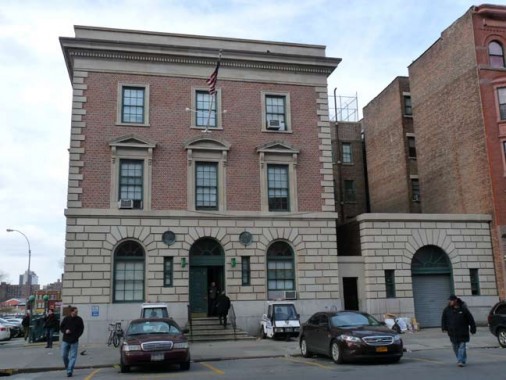
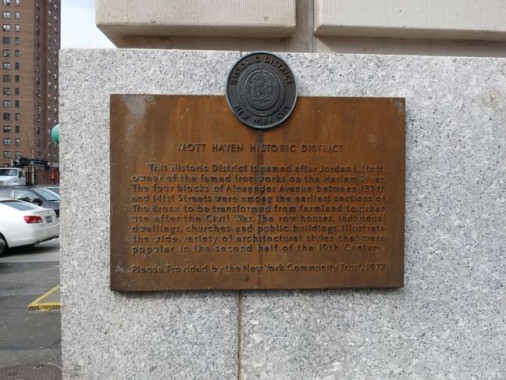
The NYPD 40th Precinct Building at the SE corner of Alexander Avenue and East 138th was designed by architect Thomas O’Brien in 1924 and inspired by a 16th Century Italian palazzo, brick with limestone quoins (corner interlocking slabs) on rusticated limestone base. It features a Mott Haven historic plaque, and the day I was there waiting for tourgoers to show up, a steady stream of perps being brought in for processing.
You can do a lot with bricks and mortar. I took an especial liking to this apartment building across Alexander Avenue from the 40th Precinct and not only because of the intricate brickwork. The doorway is nearly alive with lute and violin-playing terra cotta ornaments on the frieze above the entrance, as well as head on the steps and the columns (colonettes) by the entrance.
Clearly the architect loved his job and was having fun when he designed this.
“This five story brick apartment house, located on the corner, was built in 1892-1893 as part of a row of seventeen apartment houses extending along Alexander Avenue and 137th and 138th Streets. It was designed in the Queen Anne style by Carl A. Miliner for John Cotter and provided apartments for eight families as well as ground floor stores. The main doorway on Alexander Avenue is flanked by colonnettes, carried on stone brackets with lions’ heads, and surmounted by a richly carved frieze with cornice.”
In the dim past Alexander Avenue was called “Doctors’ Row” as many physicians working in Manhattan and further north in the Bronx (St. Barnabas) made their residences in the row houses here. This row of six 3-story brick houses by architect Richard Lomax display a large amount of expressionism with stone colonettes, segmental arches and bay windows. Much of the original iron crenellation is still there on the slate mini-roofs.
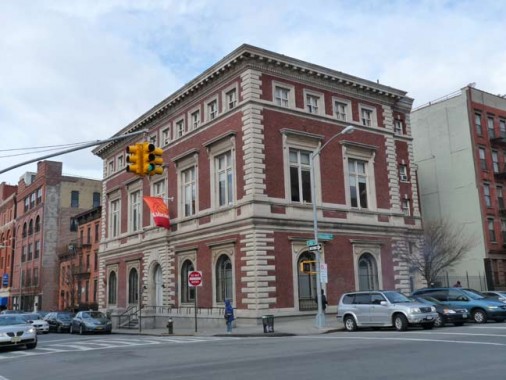
If you think the Mott Haven Public Library Building, Alexander Avenue at East 139th, looks like the 40th Precinct a block south, you’re right: both were built in the Italian palazzo style. Built in 1905, it is the oldest of the Carnegie branch libraries in the Bronx. Located on a corner lot at the intersection of Alexander Avenue and East 140th Street, it was designated part of the Mott Haven Historic District in 1966.
“Designed by Babb, Cook & Willard, architects of eight of the Carnegie Branch libraries as well as Andrew Carnegie’s own mansion on Fifth Avenue and 91st Street, the Mott Haven branch library is an ornate Classical-Revival style brick and limestone structure that recalls many of the other Carnegie branch libraries throughout the city.”
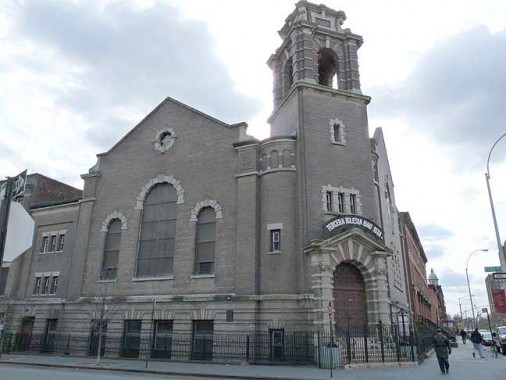
Brooklyn has been called The City of Churches, but many can also be found scattered in small areas in several Bronx neighborhoods as well.
The corner tower, which becomes increasingly ornate near the top, is Baroque in feeling with many Spanish features in the Alexander Avenue Baptist Church at East 39th and Alexander, designed in 1901 by Frank Ward.
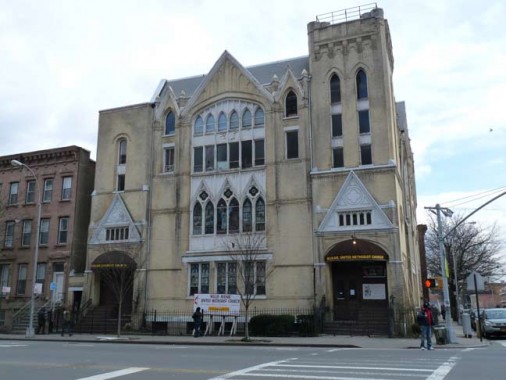
The Willis Avenue United Methodist Episcopal Church (originally Willis Avenue Methodist Episcopal Church) at Willis Avenue and East 141st Street, was built in 1900 and designed by George Kramer.
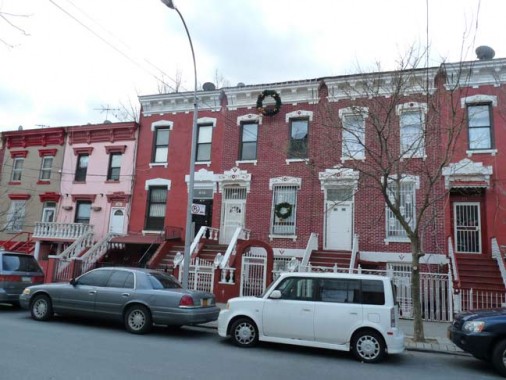
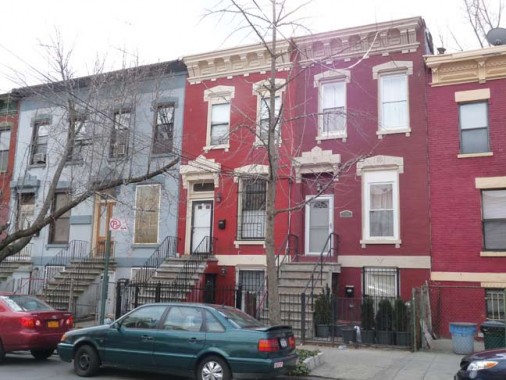
East 142nd Street between Willis and Brook Avenues. Mott Haven features several parallel blocks of attached brick buildings like this, in various states of upkeep.
This block is most famous for what was built on it long, long ago.
Patience and Fortitude, the two marble lions guarding the New York Public Library entrance at 5th Avenue and 42nd Street, were sculpted right here in Mott Haven, on East 142nd between Willis Avenue and Brook Avenue, by the Piccirilli Brothers Monument Sculptors, whose family had migrated here from Massa, Italy, in 1888. The firm also created the pediment of the New York Stock Exchange; the Maine Memorial in Central Park; Civic Virtue, the “scandalous” sculpture banished from City Hall Park to Kew Gardens, Queens in 1941, as well as Abe Lincoln at his Memorial in Washington.
It’s surprising that Mott Haven is not better known for the six Piccirilli Brothers, who were in business from 1893 to 1945. Attilio Piccirilli was the foremost artisan in the family (he executed the Daniel French portrait of Lincoln at the Memorial) and he was on good terms with Enrico Caruso, Fiorello LaGuardia, and John D. Rockefeller. No less than three Presidents, Teddy Roosevelt, William Howard Taft and Woodrow Wilson, paid a call to the Piccirilli Studios.
Just north of here, the framework for the US Capitol dome was cast at the Janes & Kirkland foundry from 1858-1861 near the Hub at 3rd and East 149thStreets.
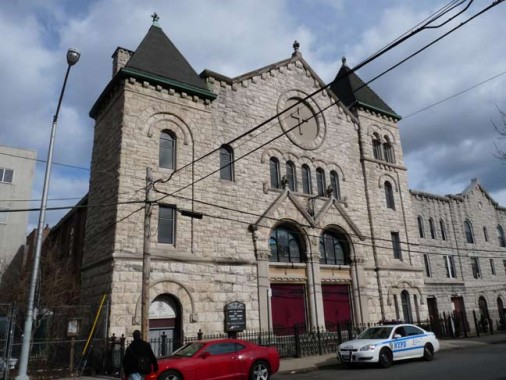

The Congregational Church of North New York, 415 East 143rd Street, was built in 1903 by architects Dodge and Morrison. Note the “North New York” name again.
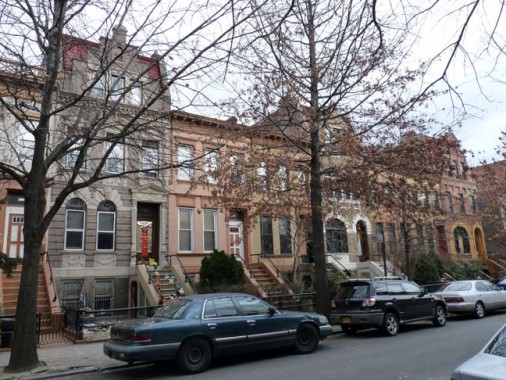
419-437 East 143rd Street between Willis and Brook, more handsome row houses built in 1887.
Heading south on Willis to East 140th and turning east again, there’s a house at #215 East 40th that has had its entrance staircase and front yard completely festooned with plush and plastic toys both times I have been by. The owner didn’t come out, so I didn’t get his story. Perhaps they were for sale. If there’s any Mott Haveners reading this, let me know.
Generally speaking, East 140th between Willis and Brook could be Mott Haven’s best, architecturally. The attached townhouses lining East 140th Street go back to between 1877 and 1892. Note the Dutch and Flemish-style pediments on some of the houses.
St. Peter’s German Evangelical Lutheran Church, 435 East 140th, was built by architect Louis Allmendinger and completed in 1912. As the cornerstone attests, the congregation was established in 1890.
St. Peter’s German Evangelical Lutheran Church was organized in 1890, with first services held on East 142nd Street and Alexander Avenue. In 1892, the society moved to East 141st Street near Willis Avenue.
The present church, located midblock on East 140th Street between Willis and Brook Avenues, was built in 1911. To the west of the church is the two-story parsonage, built in 1912. Louis Allmendinger designed both structures in a neo-Gothic style, using gray brick trimmed with terra cotta and limestone. The church and parsonage are at the end of a row of eleven unusual brownstones designed by Walter Hornum and built by developer William O’Gorman. The block is within the Mott Haven East Historic District, designated in 1994 by the New York City Landmarks Preservation Commission.
Over the years, the congregation dropped its German-language services in favor of English. As the German and Irish residents moved out of the Mott Haven neighborhoods, the brownstones and tenements became home to many black and hispanic families. Today the congregation is known as St. Peter in the Bronx Lutheran Church, and is a member of the Evangelical Lutheran Church in America. NYC American Guild of Organists
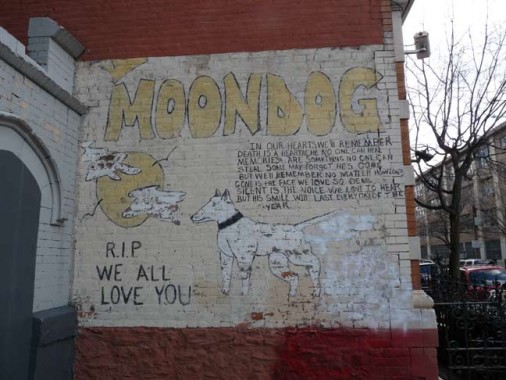
Many Bronx wallscapes have tributes to neighborhood residents who died young, for whatever reason. This one has been here a long time, adjacent to the church, and its paint is chipping off now.

The two flags on the left are the flag of Puerto Rico; the one on the right is the tricolor Pan-African Flag, created in 1920 by the Universal Negro Improvement Association and African Communities League (UNIA) headed at the time by Marcus Garvey.
The Puerto Rican flag design was adopted in 1952 and closely resembles its model, the Cuban flag (the colors are inverted).
St. Ann’s
St. Ann’s Episcopal Church, St. Ann’s Avenue between East 139th and East 141st Streets, is The Bronx’ oldest church, having been built in 1841 and dedicated to Gouverneur Morris’ mother, named, naturally, Ann. Several members of the Bronx’ most noted families of the colonial era and beyond are buried in the church’s graveyard, including Gouverneur and Lewis Morris.
Before much of Mott Haven was purchased by Jordan Mott for his iron works in the 1840s, Mott Haven was owned by the Morris family.
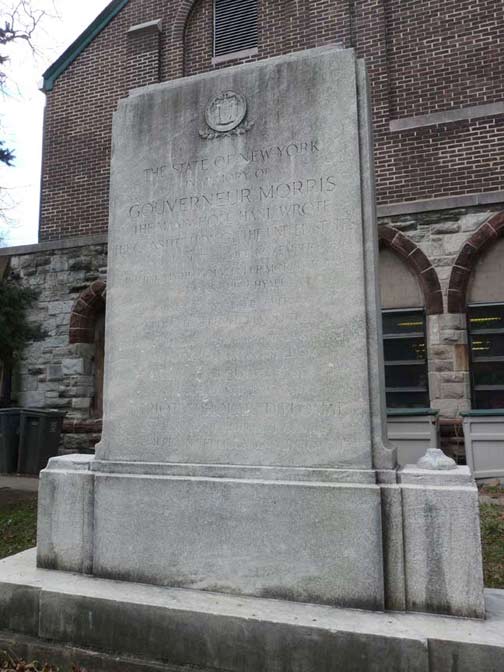
Gouverneur Morris (1752-1816) half-brother of Lewis Morris, was a political leader, diplomat, U.S. Senator, and American ambassador to France. He was an outspoken opponent to what he termed ‘unchecked popular democracy’. His son, G. Morris II, sold the estate to Jordan Mott.
Gouverneur Morris was outspoken and brash – nonetheless, he became ambassador due to his through knowledge of the French language and its nuances. In his youth, he would drive teams of horses without the benefit of reins, yelling and cracking a whip instead, but one day one of his teams ran off and he was dragged, winding up with a crushed leg. For the rest of his life he hobbled along on a wooden leg, like a Dutch predecessor, Peter Stuyvesant.
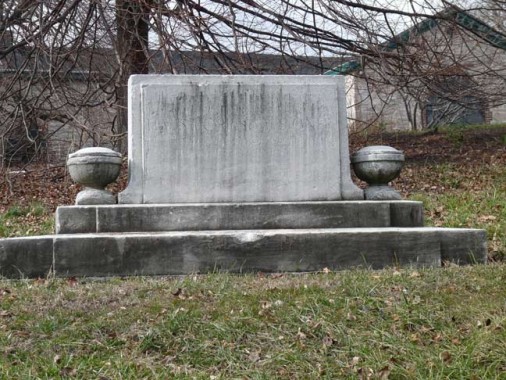
Lewis Morris (1726-1798) was an ardent supporter of American independence and served in the Continental Congress from 1775-1777, and in the NY state legislature between 1777 and 1790. He signed the Declaration of Independence in 1776. His great grandfather (Richard, died 1672) had immigrated to New York through Barbados after being part of Oliver Cromwell‘s army in the English Civil War of 1648. He purchased the first tract of land in the Bronx that became the basis for the Morrisania manor. wikipedia
Also interred here is Judge Robert H. Morris (1802-1855), a three-term mayor of New York City from 1841 to 1844.
As an aside, Morris Park in the Bronx has nothing to do with this Morris family. It is named for John Albert Morris (July 1836 – May 25, 1895), an American businessman widely known as the “Lottery King” and a prominent figure in the sport of Thoroughbred horse racing. John Morris owned a large racing stable in the United States and another in Europe. With Leonard W. Jerome (grandfather of Winston Churchill) as his minority partner, in 1889 he opened Morris Park Racecourse in Westchester County, New York. The facility hosted the Belmont Stakes from 1890 through 1904 as well as the Preakness Stakes in 1890. wikipedia
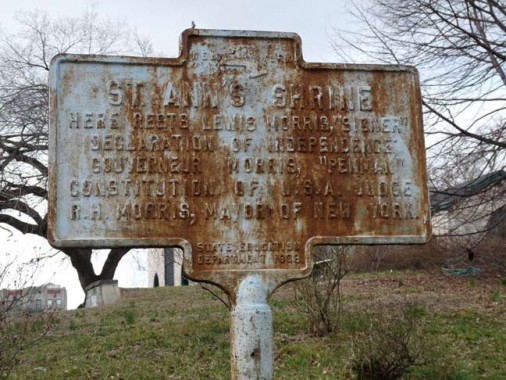
One of NYC’s few remaining State Historical Markers can be found here, in decrepit and rusting condition. FNY did a complete survey of the remaining signs in the spring of 2013.
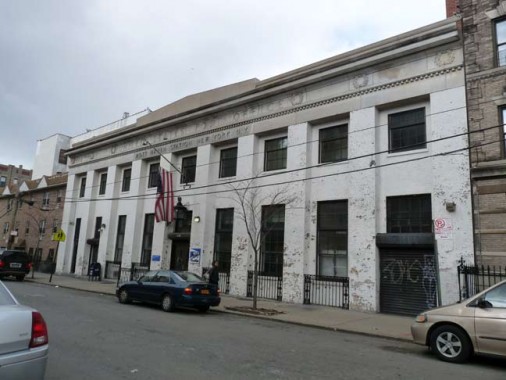
A look at the cornerstone reveals that Mott Haven’s distinctive post office, East 139th between Brook and St. Ann’s Avenue, was built in 1935 when Henry Morgenthau was Secretary of the Treasury and James Farley was Postmaster General.
After 1937, while still in charge of the Treasury, [Farley] played the central role in financing US participation in World War II. He also played an increasingly major role in shaping foreign policy, especially with respect to Lend Lease, support for China, helping Jewish refugees, and (in the “Morgenthau Plan”) preventing Germany from ever again being a military threat. His son Robert Morgenthau was the longtime District Attorney for Manhattan from 1975-2009.
James Aloysius Farley was one of the first Irish Catholic politicians in American history to achieve success on a national level, serving as Chairman of the New York State Democratic Committee, Chairman of the Democratic National Committee and as Postmaster General simultaneously under the first two administrations of President Franklin D. Roosevelt. He was one of the first Roman Catholics to achieve national success; Al Smith had run unsuccessfully for President in 1928. He was a champion of civil rights in the 1920s, as Chairman of the New York State Athletic Commission, he unsuccessfully tried to integrate boxing, as after Jack Johnson’s success, promoters colluded to keep African-Americans from challenging for titles. Later, he was CEO of Coca-Cola and helped spread the brand worldwide. wikipedia
The main branch of the post office in Manhattan at 8th Avenue and 33rd Street is named for Farley. There has been talk for many years about making it the new Penn Station Building (Sen. Daniel P. Moynihan urged the project and whenever anything is done it will be renamed the Daniel P. Moynihan Station).
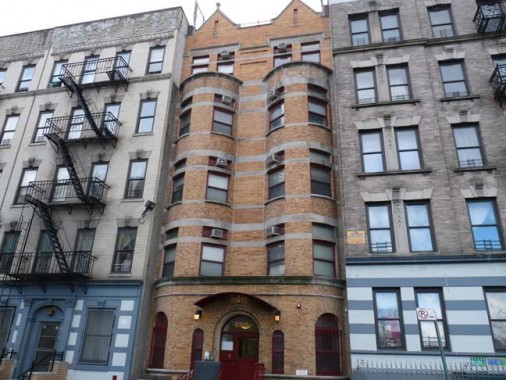
This distinctive castle-like narrow apartment stands on East 139th near Brook Avenue across from Saw Mill Playground, named for the former Saw Mill Creek, a.k.a. Mill Brook, which was long ago moved into the sewer system, though Brook Avenue is also named for it.
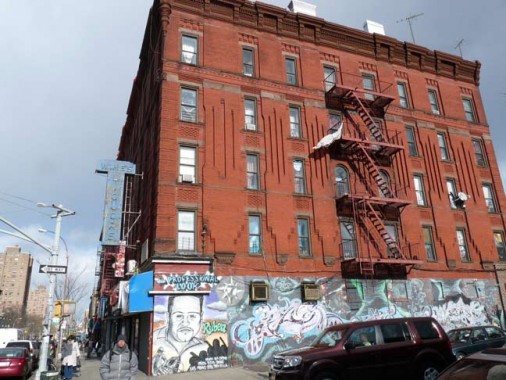
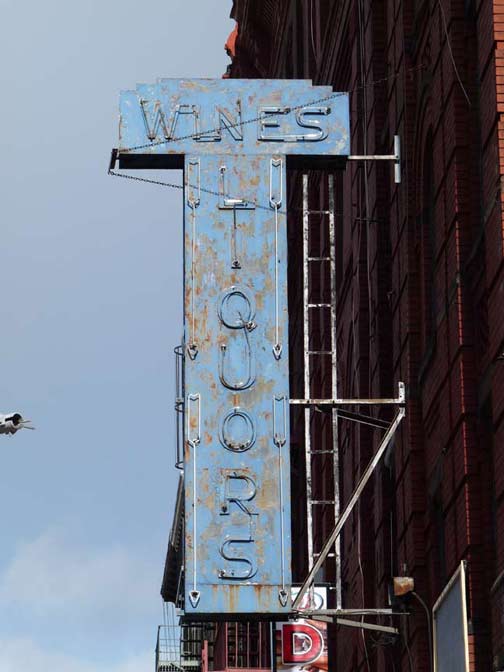
This apartment building at Willis Avenue and East 137th closely resembles the earlier one seen at Alexander and East 138th, but without the ornamental friezes. It does boast a huge neon liquor store sign.
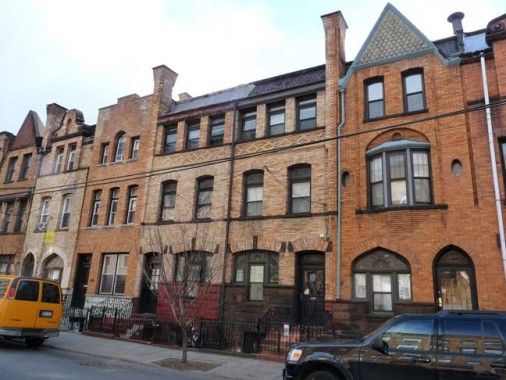
“In the 1890s, three rows of attached houses were erected on East 136th Street between Willis Avenue and Brown Place. These three rows, comprising a total of twenty houses, were built by developer Edward D. Bertine who spent $63,500 amassing property on 136th Street in 1891. Little is known about Edward Bertine. Listings in New York City directories indicate that he had been a Manhattan milk dealer in the 1870s and early 1880s, branching into groceries by 1883. In 1889-90, Bertine first appears in the directory as a builder. All of the buildings that Bertine is known to have erected are in the Bronx, and, following the completion of his first row on East 136th Street, he moved into a house on the block.
In 1891 Bertine began construction on a row often houses on the south side of East 136th Street.
Designed by architect George Keister, this is one of the finest rows erected in New York City in the late nineteenth century. Keister had designed several theatres in the Times Square area, including the Selwyn and the Belasco, as well as the Apollo Theatre uptown. Other houses in the Bertine rows were designed by architects John Hauser and Adolph Balschun Jr.
“Each house is faced with tawny brick above a rock-faced stone base, and ornamented with trim in brick, stone, stained glass, and slate. There is variety of design elements, including those of Romanesque, Gothic, and Flemish origin.”
In the above, the sections in quotation marks are from the LPC Mott Haven report.
Port Morris
This is an industrial and warehousing part of town located between the Bruckner Expressway and East River, with Bronx Kills as its southern border. I had only been to the area once before when I visited the New York Post printing plant on East 132nd Street with my pal Dawn Eden, when she was working as a copy editor there. And, the ride was at night, so I barely saw much outside the van window.
Rumor has it that there may be a treasure cache under Port Morris’ mean streets. In McNamara’s Old Bronx, the late Bronx historian John McNamara reports that during the Revolutionary War British frigate the HMS Hussar ran aground while transporting British army pay, a fortune in silver and gold coins. Subsequent landfill in the 1850s may have buried the Hussar and its treasure under Port Morris. It’d take a major effort to try and raise it now.
In2013, a cannon removed from the Hussar and placed n Central Park was found to still have gunpowder inside the cannon bore. It was removed and disposed of at a gun range, possibly the last active armament from the Revolutionary War.
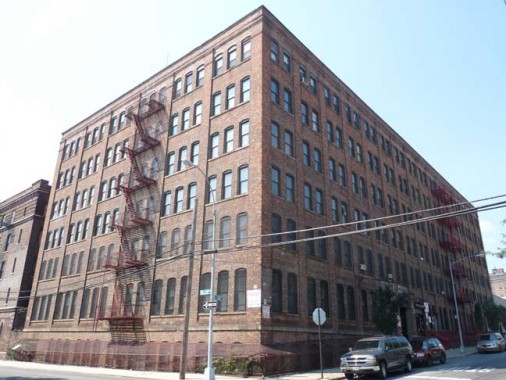
Another of those imposing brick factory buildings I have an admiration for, at willow Avenue and East 136th Street.
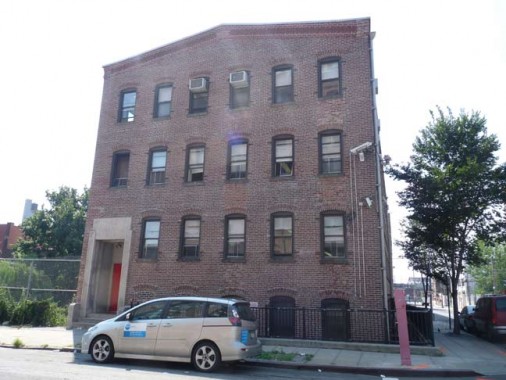
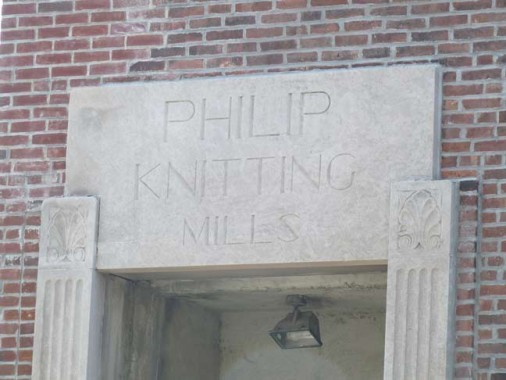
Philip Knitting Mills, in a brick factory with Deco touches at the entrance. Morris Philip (who has an appropriate first name in this part of the Bronx) was the firm’s founder. Besides having patents for some specialized knitting machines, he’s most famed for inventing the Philip Cup, the splash proof coffee cup lid. The Philip Cup factory was located at 26 Bruckner Boulevard.
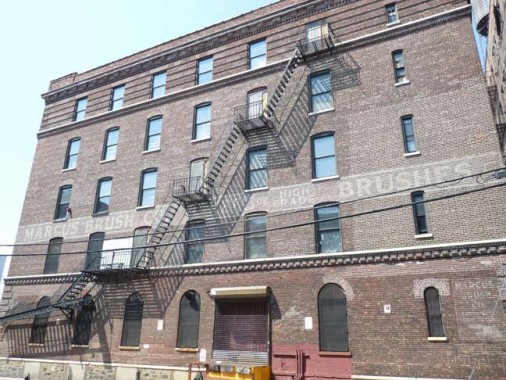
Marcus Brush Company building, Willow Avenue and East 135th Street. There is a Marcus Brush in Chicago: I don’t know if moved there from here.
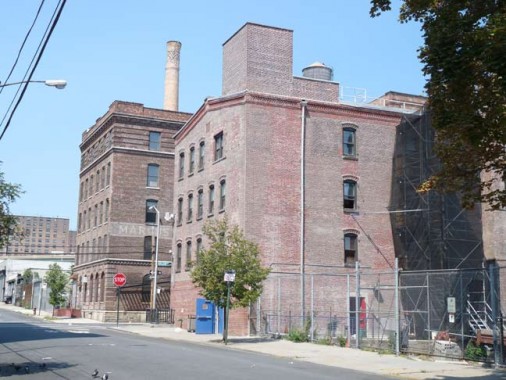
East 135th looking back toward Marcus Brush, its smokestack and another gorgeous old factory on Willow Avenue.
Port Morris’ three north-south avenues, Willow, Locust and Walnut, are named for tree species once prominent on the farm belonging to a servant of Jonas Bronck, the Swede who was the original white settler in what became the Bronx.
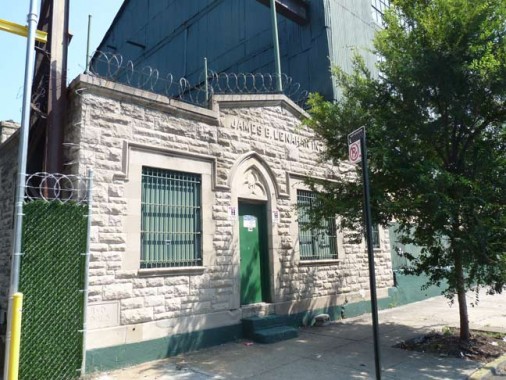
This small stone building marked James B. Lenahan was likely once the office to an adjoining firm owned by that person.
As it happens, I found Lenahan’s biography rather easily:
JAMES B. LENAHAN – President of the cut stone concern of which his father, Bernard J. Lenahan, helped to build up, and of which he was president until his death in 1915, James B. Lenahan is known throughout Greater New York as one of the largest dealers in cut stone for building purposes in The Bronx. Among the jobs for which he has supplied materials are about twenty public school buildings, for the old Twenty third Ward Bank, for the Dollar Savings Bank, now The Bronx County Trust Company, the Irving Columbia Trust Company, Fordham branch of the Corn Exchange, the Concourse Plaza, Bronx Terminal Market, and many apartment houses in The Bronx and Manhattan. He also supplied stone for the entrance and approaches to The Bronx Zoo and Horticulture Building, in Bronx Park, and the Nurses’ Home on Brother Island. Online Biographies

This double set of tracks carries Amtrak passenger trains en route from Penn Station to Connecticut, Rhode Island and Massachusetts destinations, including Boston. South of Port Morris, the tracks pass over Wards and Randalls Islands and then over the Hell Gate Bridge into Queens. Freights bound for the Oak Point Yards or Fresh Pond Yards via the NY Connecting Railroad also use the tracks.

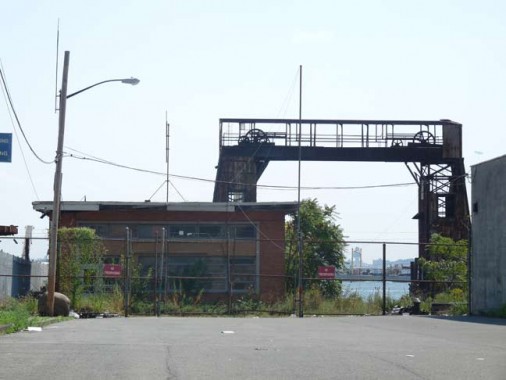
A pair of gantries, which facilitated the transfer of goods from East River shipping vessels onto railroad tracks, sit rusting and idle at the end of East 135th Street. While a set of similar gantries have been restored as part of Gantry Plaza State Park in the rapidly evolving southern tip of Hunters Point in Queens, these are awaiting revival, as is Port Morris itself.
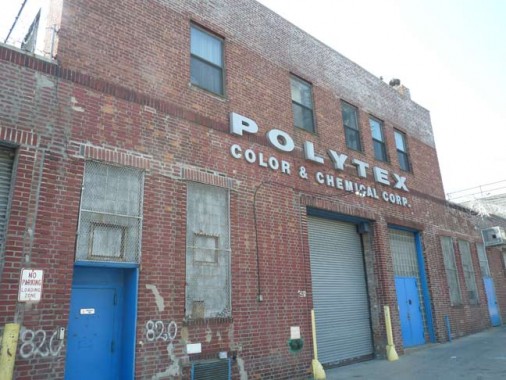
Polytex, on East 140th near Bruckner Boulevard, makes commercial greenhouse, high tunnels, retail greenhouses, retail display fixtures, greenhouse accessories, poly film and shade structures.

Super Fuel, across the street, still boasts the heavy plastic sign lettering that seems to be most popular on paint stores. The firm was established in 1936.
La Flor de Mayo Express, a moving firm on the west side of Bruckner Boulevard between East 140th Street and Wales Avenue, boasts a beautifully designed and painted example of wall painted ads — very rare in this day and age. Apparently a previous painted sign was followed literally to the letter — the old telephone exchange, LU, was repainted! LU stood for LUdlow, which was used exclusively in the Bronx.
I pressed on toward West Farms after this, but that’s for another page.
11/3/13


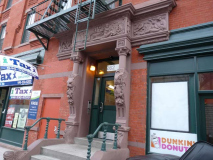
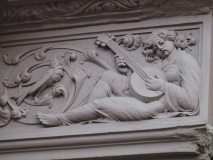
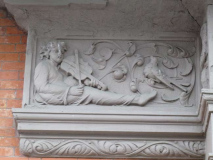
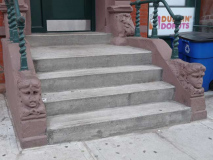
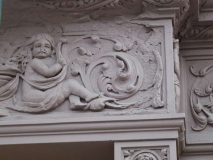
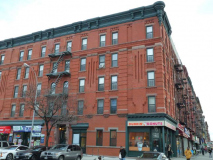
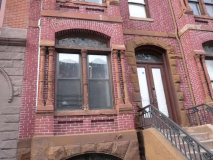
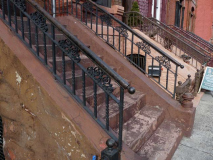
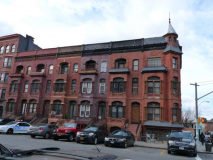
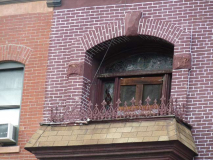
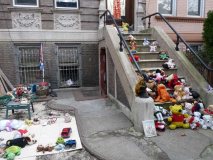
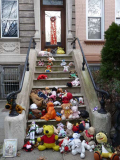
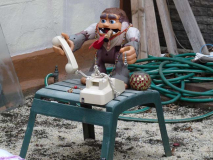
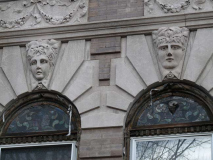
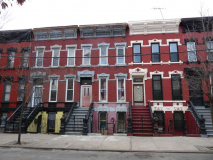
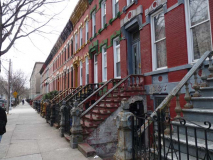
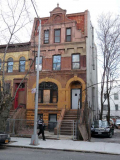
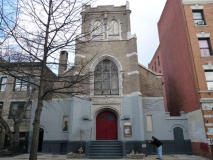
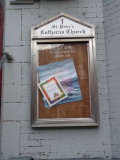
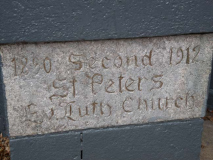
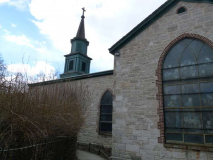
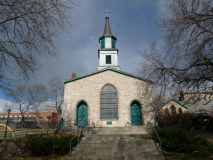
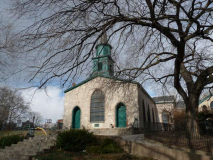
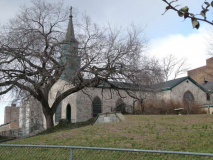
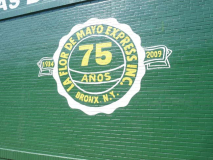
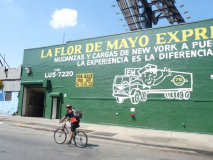
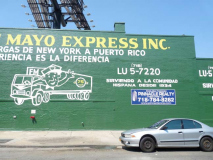
66 comments
Nice page Kevin! Where did they recover that cannon from the Hussar?
Excellent. Very well done.
I am a Bronxite. Born, raised, educated (CUNY Lehman.), home-owner (Woodlawn), raising my family here in The Bronx.
I was Commissioner of NYC’s Dept. of Records 2002-2011.
I was also the originator of the 350th Anniversary of The Bronx celebration (in conjunction with the Borough President’s Office) in 1989. It came on the heels of discovering (through conversations with Lloyd Ulan) and proving and promoting the Swedish ancestry of Jonas Jonasson Bronck.
FYI, 2014 is the 375th Anniversary of Bronck’s arrival and the Centennial of the formation of Bronx County.
All the best to you and keep up the good work!
BGA
I enjoyed your comments on Secrets of NY, back in the day.
A nuglet of info re St Jerome’s Church. The original outdoor statue of St Jerome at the corner of 138th and Alexander crumbled in the late 1950’s and was
replaced by a similar but slightly small version.
I used to live on 1240th between st. Ann’s ans Cypress. Went to st. Ann’s church many times. My whole block was torn down in the early 80’s.
What an amazing revival. I worked in The Hub, 1972-74 & I witnessed the ongoing destruction of the South Bronx. A trip on the Bruckner Expressway or crossing the Willis Ave, bridge reminded me of Berlin immediately following WWII. Thank you, Mayors Giuliani & Bloomberg for the right policies at the right time. Too bad the era of revival will soon end.
You got that right! Here comes mayhem!
Those old gantrys may have been old ferry slips servicing the Bronx and Queens. I can’t tell from the photo.
Possibly the ferries to North and/or South Brother Islands.
I’m pretty sure the gantries mentioned (and pictured) were operated by the New Haven Railroad Co. They were used to load freight cars onto or off of barges (which railroaders called ‘floats’). Because of New York’s huge amount of waterfront the railroads made extensive use of waterborne transfers between various rail lines. The piers at Port Morris possibly handled traffic to and from the rail yards in north Jersey along the Hudson River.
Is it possible these gantries were also used for ferries that shuttled people to and from Rikers Island, before the bridge between Rikers and Queens was built? I do believe this was the site for ferries to N. and S. Brother Islands. My great uncle worked as a salesman for Rupert Brewery, and Rupert himself had a home on S. Brother. My great uncle attended his annual Christmas bash until Rupert’s house burned down.
Some of the images on this page I see a lot when I going to the Third Avenue Bridge from the Major Deegan Expressway with others from the part of the same highway just after the interchange with the Bruckner Expressway.
I saw that very same house with all of the toys when I was exploring Mott Haven a few months ago. Would love to know what it was about.
This house use the steps to sell the use product for profit.
Sort of a second hand store with having to pay rent. I hope that answers your question.
Kevin, as always you have found an interesting corner of the city. I particularily like the St. Ann’s pix, not to mention all your beloved brick industrial’s. I think they are pretty cool myself.
GREAT WORK KEVIN…….. gAVE ME CHILLS TO SEE BUILDINGS AND BLOCKS IN THE S. BRONX THAT I GREW UP IN DURING THE 30S ,40S AND 50S. ONEPHOTO WAS OF MY BUDDYS HOUSE ON 142ND STREET. USE TO PLAY WHERE THE MONUMENTS WERE
AT 142ND NEAR BROOK AVE.I HAVEN.T SEEN THAT AREA SINCE 1954. THANKS AGAIN!
Great site. Our Family left in 1960 When I was in the Army. The Bronx with all if it’s parkland {35%?}and architecture is a beautiful borough….many fond memories. I often wonder why that area is now lacking in Diversity of population it once had.
Another great tour of a little-known (at least by me) part of NYC.
It’s a real shame to find out St. Jerome Catholic School closed. Both my mother and I went there. It was a great school to go to.
Kevin I grew up on brook avenue and 140th street and went to st lukes school on 138th street my bedroom window looked out onto st ann;s church yard and when it snowed it looked like a christmas card loved your pictures
OMG, fantastic stuff…makes me wanna go c the old neighborhood (14h2nd&Brook),this time I’ll kno what to look for. How about some insights on that Franklin/Fulton Ave area…its pretty old there too .
I lived on the hill on 139th Street between St. Ann’s Avenue and Cypress Avenue. Looking west at sunset you could see the Gothic buildings of City College glowing like a fairy tale castle on the heights above the street. Our street was favorite sledding place. We’d build snow forts to cut off traffic. We also had huge bonfires on some election nights (we had a very large empty lot). I remember the fire for Truman’s victory in 1948. It was a great block party. A favorite thing to do in the winter was to roast potatoes in fires in that empty lot.
There were so many kids living on that block that we were organized into 3-4 groups, with many of us not knowing kids in other groups.
I remember the summer seasons. Peashooter season and linoleum gun season with “forts” made on fire escapes with blankets. We also had chalk art week where the whole neighborhood was blanketed with elaborate chalk drawings. We also had huge “reenactments” of movie battle scenes, with discarded oranges the weapon of choice and swords made from curling up newspapers. Adults used to sing and dance or recite poetry in the street on summer nights while we kids played flashlight tag in the backyards. We’d often put a garbage can with no bottom over the fire hydrant, causing a huge water spout and “rain.” A game was to use a can to spray the water from the hydrant into the police car summoned to turn the hydrant off. There were endless “crossing the street games,” stickball games, and endless games of kick the can.
The kids i hung with used to sneak on the subway to explore the city, especially the Zoo, Bronx Park, Central Park, Pelham Bay, and the the two museums on Central Park. At one point we knew where everything was in the Metropolitan Museum of Art (with no attempt back then to collect an admission fee). We went to the Port Morris industrial section during a hurricane, tied ourselves to metal posts so we wouldn’t get blown away, just to see what a hurricane was like. Miraculously we were not hit by all the heavy flying debris. During one huge snowfall we built an elaborate “WWII” series of tunnels, bunkers and forts.
I wasn’t in a gang but I played football for a gang team. The movie “The Wanderers” always reminds me of those games. The neighborhood “championship” stickball games drew a huge number of gamblers and the mob bookies. Candy stores were also bookie joints. The first “heroin parlor” was opened on our block and some of my fiends’ older brothers became addicts.
The Osceola movie house was just around the corner (on St. Ann’s Ave), with its riotous nickel Saturday triple matinees and the matrons beating their yards sticks and screaming to get the kids to quiet down and sit in their seats and not jump off the balcony. The big theatre was on 149th street, where it was impossible – we didn’t know it, though – to avoid getting a contact high from all the marijuana being smoked at the shows. My experience of Dumbo and other Disneys was psychedelic but I didn’t figure out why until years later.
We used to choose up “gang wars,” with strict rules (for instance, you could not hit anyone in the face or below the waist, except in the thigh). We used to sit on the stoops, with one group “sounding” (insulting) another group back and forth for one to two hours at a time, in the manner of ancient battles.
Life on the roofs was active and rich, with games designed just for the roofs. Some of the crazier kids used to hang off the roof pediments reading a comic book. Others ran down the wide platforms from roof pediment to pediment from the top of the hill until the end of the pediments, jumping down about three feet from roof to roof and running faster as they went. No one ever fell.
There were many other games and events and seasons. It feels like centuries ago. Another New York, another America.
Sorry, I left out all the classical music on our block. It was part of the summer street show that the adults put on.
Thanks for your great post, John. It’s wonderful to hear firsthand some of what the neighborhood was like just a bit before I was born there in the mid-50s. I am still there, on East 136th Street near Willis.
I also wanted to add my thanks for including Mott Haven and Port Morris on FNY. I don’t know them well but I have explored them several times over the years. The area has become much more pleasant than it once was and I hope that trend continues. It was very sad to see that the City of New York seemed to be virtually abandoning the area in the 1970s.
Great post! I was wondering though, do you have any info about the old factory on 143rd and Brook? The one that is now a CubeSmart Self Storage?
well this is an eye opener especially since I have always wanted to live here.Thanks for the tour guide.
what is the history behind the old iron gate and fence on E.143 street between brook and st.anns avenue, Bronx ny?
I lived at 415 E. 143rd st. from 1938 until 1953. My Dad was the minister of the church. If anyone remembers me I am in NH now at pelonpaul@gmail.com
Today you are my favorite person! I am researching family history. I have never been to New York, but my father’s entire family immigrated there in the 1880s. He grew up on Alexander Ave. and his grandparents ran a funeral home there. Hunter-Kingsley. I have bits and pieces of oral history and (now) lots of census records. I was particularly interested in Mott’s Iron Works as my great-great grandfather immigrated in 1846 (age 10) and became an iron moulder and lived on Franklin. I was told that many of the wrought iron rails were made by him. Any idea if I can find out about the crafters of that time? Thanks for all the great pictures. After all this and your photos and history lesson, I feel like I know the place!
I too grew up in Mott Haven, initially on 136th between Willis and Brown Place then on 140th between Willis and Brook. I have many fond memories growing up in the Bronx. I went to PS-43, PS-9 and the old Clark J.H.S.. During this time I built model airplanes and flew them in Pelham Bay Park. I went to St Jerome’s Church until I was about 12 (I am now 71). This is when Billy Moriarity and I realized that if we combined the money we had for donations, we could walk up to 149th Street and split a Chicken Chow Mien meal and have 10 cents left over for a tip. Billy and I did this until my enlistment in the 82nd Airborne at age 17 1/2. I hope this was not the cause of it’s unfortunate closing!
PS: I would really enjoy getting photos of model flying in the Bronx as well as names of other flyers.
Joe Lenyi – Woodbridge, VA
joe11611@aol.com
http://www.dumortier-us.com
I was brought up at 335 E, 135th Street. As a child I remember the building of the highway that connects the highway that connects the Triborough Bridge and the New York Through Way between 134th and 135th Streets. I attended PS 43. The school song started with ” P.S. 43 in my heart you will always be now and forever more……..” . Now there is a Public School on the site on the corner of Alexander Ave. and 135th Street. The Third Ave. El ran through the block between Alexander Ave and Willis Ave. heading north. When I think of the South Bronx I think of everything below 149th Street. Now the common use of the the term The South Bronx seems to be expanded. I was one of the few in the area that went to public school most went to St. Jerome”s on Alexander Ave. and 137th Street. Along with my friends we would get free tickets to Yankee Stadium from the PAL and often walk to the Stadium. Most of the weekday games were day games in the 1940’s. Most of the Bat Boys came from the south Bronx in those days. Many of the Yankee players lived in a hotel on 161st Street and could be seen walking into the local stores.
Hello,
I am a native new Yorker, born on lower east side, moved to East Harlem, later on to the Bronx. I recall stick ball games, scullsy played on sidewalks or streets. When Robert Moses gave the okay to build the x Bronx xpressway, it tore apart the Bronx. I do recal south Bronx in he early 1970’s, heroin, gangs, landlords setting fires to their buildings in order to get insurance money. PureChaos.
Ed Koch gave away the city to big time developers. I recall the 3rd ave L train , and they took it down in 1974. REcall Yankee stadium, being rebuilt in 1974, that year the YankeessharedShea Stadium with the mets while the fixed yankee stadium. The house Ruth built and Lindsay Rebuilt.
Wonderful
I just found your site and this page. I’ve been researching my family and discovered today that my great grandmother’s sister lived and died at 667 East 138th in the 1890s. Does anyone know if that corner of Cypress Avenue and 138th still has houses or were they torn down?
Jan Briggs I know this is an Old Comment but No the Corner of Cypress Ave & 138th, doesn’t have Houses now. The Corner of that Block has Tenements Buildings.
Great page! My Nan lived at 416 east 137th in the late 1920s and 1930s before the family returned to Ireland (not sure when). It’s lovely to see their neighbourhood!
Those houses on Alexander Avenue are beautiful and the almost dubbed “piano district” isn’t without its charms, but don’t get it wrong… this area is still vicious. It happens to have one of the highest concentrations of public housing and social service agencies in the city (don’t quote me on that). A few years ago I read about a condo that sold in the area (on 3rd Avenue) for just shy of a cool million http://ny.curbed.com/2014/4/24/10110046/this-900k-condo-is-south-bronxs-most-expensive-apartment The interior was downright palatial!! The downside… it was DEEP in the heart of the projects. Still, as someone who spent the better part of 10 years working and walking in that area, I appreciate your eye for detail and finding the beauty in what I would find mundane.
I was also born and raised in The Bronx … this is my neighborhood right here. We lived on Jackson and 149th Street while my grandmother (who we spent most of our time with) lived at 950 Union Ave. Recently I took my daughter around my old stomping grounds and wanted to cry. 149th and Jackson has changed by leaps and bounds, (hell I used to go to PS 5) and the worst part was Elmer Bogart IHS has also been changed. I remember when I was a little girl going to PS 5, I used to dread “Senior Day” … 950 Union Ave is of no more while they kept the address, all of the buildings around it are gone. I related to my daughter the carefree days of going to St Mary’s Park and being able to do arts and crafts and how actors used to come and do fairy tales. I showed here where both sides of the swings were (only one side has swings now) and where everyone used to go have picnics. I showed her the ball park (how many summers did they play baseball in there) and where we used to roll down the hill (can’t do that now, you are liable to be ribbons when you are done) Ahh the joys of childhood, to bad we all had to grow up. I miss my youth
Absolutely classic part of both historic and underground New York. Lets not forget hip-hop in the late 1970’s which blurs those 2 lines too.
Several of my ancestors were baptized and married at St. Mary’s PE Church on Mott Haven in the early 1900’s. The church was located at Alexander Ave. and 141st St in the Bronx. I cannot seem to locate a photo of the church or any information on it. Can you direct me to a source?
Hello,
I would like to add, today we here a lot about gangs and gang activity. Back in the late 50’s and early 1960’s there was much gang activity in the Bronx and all over the city of NY. Gangs are nothing new, been around nyc for a few centuries.
Does anyone recall the ‘ Capeman” ? He killed a teenager in Hells Kitchen, later on Governor Rockefeller pardoned him, as he was scheduled for execution in the electric chair. If I recall the case, they did testing and found out he wasn’t able to read or write, and had a very troubled childhood.
The Capeman and Dracular hanged out in 120th East River Drive (Pleasant Ave) and both went to prison and they might be dead by now. My family was transferred from Wagner Houses to the Mitchell Projects (Willis Ave 138th) in the 70s. These two individuals were always in our neighborhood until their arrest. The gangs were in both of our neighborhoods. Our Boys Scout Troop 660 had our meetings in a basement on 138th Street, even though we were from 120th Street. I have great memories of the 138th, playing football in the winter, especially our annual Thanksgiving Day game, basketball and stick ball. We even hanged around the medical office at 175 Willis Ave (we lived on the 7th Floor. Some of us played softball for the restaurant (Ceveres) on 138th. So we really didn’t get into too many incidents.
Thank you for taking the time to put together this page. I grew up in Mott Haven, 141st and 3rd Ave. This brought back memories. I had friends who attended the churches that you had on the page. In high school, I worked at the public library located at 140th street and Alexander Ave. I never referred to it as the South Bronx but Mott Haven. I am happy to see that the name is coming back.
This is wonderful! Thank you for sharing! I run an online video channel and website called WALKS NY and we film and/or photograph self-guided (such as this one by you) walks in NYC. This one is a must-do for us 🙂
My Great Uncle lived at 541 E135th St. at the corner or St. Ann’s Ave. He also owned a saloon right there in the early 1900s. Is there any way to find out the name of the saloon? I have a photo of the apartment building if you would like to see it!
Thank you!
i have a small scene in my film, with charlie mott’s father. not sure if it will work.
• I was born in St. Francis Hospital on 143rd Street between Brook and St. Ann’s Avenues in 1953.
• Lived (raised) on 139th Street between Brook and St. Ann’s Avenues for 17 years (building next to the Post Office).
• Attended PS 9 till it was burnt down over the Christmas holidays.
• Transferred to PS 30, then attended Burger JHS both off of 141st Street and Brook Avenue.
• Attended Central Commercial HS (67′ – 71′) , then attended NYCCC in Brooklyn.
On Brook Avenue between 139th and 140th Streets were two Chinese businesses, a Hand Laundry store (the Lai family) and a “fast-food” Chinese Take-Out restaurant (the Chue family). My brother and I hung out with the 7 offspring’s of these two families. We were excellent handball player (Peoples’ Park) and made the handball team of our respective high schools. Played all our basketball and touch football at the Willis Avenue Projects (140th Street / PS 49). Tough neighborhood but great times.
Hey Frank! I lived on 139th and Brook Ave as well as St Ann’s Ave. I also went to PS 9, I lived right beside PS 9 next to the yard, sometime there were carnival set up and I worked for change…played stick ball and touch football on 139th, I also hanged out at Willis Ave. That Chinese Rest had the best Shrimp Fried Rice ever! I witness the day PS 9 was burned down, sad day! some many good memories… Do you have any old pics that you would like to share?
Enjoyed your site. My family Deegan had a piano moving business at. 262 e. 143 rd St. Back in 1918.
I actually cried with this website…I grew up in the Bronx on 139rg between Brook Willis then 140th between Willis/Alexander. Attended St Jerones and actually have lots of dreams if school/church/convent/Eectory. The library and 40rhvprecibxts most memorable. Dunno why don’t renember St Ann’s but remember St Lujes. Brown Pkace? Hope to return some day and reminisce. Any contact info for historical connections greatly appreciated
Loved looking at these memories. Born in 1949 at St.Frances Hospital and lived in an apartment building on 142nd and St. Ann;s Ave. Attended St. Ann’s Episcopal Church. Went to PS 65, Alexander Burger JHS and Central Commercial HS. Left the Bronx in 1971 to live in Rockland County. I live in NC now and think a lot about the beautiful buildings in the Bronx.
Hi Ginny, I don’t know if you’ll see this as it is now 2121. I was born in 1948 at Prospect Hospital, where ever that was. I’d walk past St. Francis Hospital and St. Joseph’s Hospital on my way to Burger JHS from where I lived on St. Mary’s St. across the street from St. Mary’s Park. We must have been in JHS at the same time for a couple of years. Do you remember Mr. Lobel, Mr. Buchanan, our principal Mr. Weinstein? I went to P.S. 65 and attended St. Luke’s Church. My friends, Persida and Beth Ann went to St. Ann’s. I live in Berkeley, CA now, but have the best memories on the Bronx. My name is Virginia.
Hector had lot of friends in bronx since my friend was gone about three months ago soon as hector move from lakeland in florida to new house in the bronx.
will be back to bronx soon as possible after moving out of florida to new york city.
regrets that i discovered this site so recently. you have caught the neighborhood. the northside building you refer to was the the home office of the northside savings bank. j. clarence davies’ real estate office was just around the corner — he was the man who amassed all those old photos of the city which we buffs love to look at today. donovan the spy swapper grew up on doctor’s row and bobby darin went to clark junior high. the iron gates somebody asks about may be from the st. joseph tb hospital, where more patients went in than came out. we saw some of the pr nationalist gang that shot up congress in 1950 get arrested in the apartment house next to the post office.
I was a student at PS9 and its was a very sad day when I saw my school burned down…I was so nerves when the fireman asked to leave the apt and there was ice on the stairs outside the building right next to the school (139th) and I remember my slip and fall of that day! wow what a day!
Hi, very interesting.
I search where was the Athletic Ground at Mott Haven near 1892. These grounds were lighted for practice different sports at evening. In different book, I read “New York Athletic Club grounds at 150th street near Mott Avenue”
But I don’t find maps of this period that confirm that !
Thank you very much from France !
Quite an interesting page. Showing the decline of American production too American consumerism… Maybe one day America will become a manufacturing powerhouse again one day, but for now, it doesn’t look possible.
Also your reCaptcha device teaching Artificial Intelligence that real people need to tell a computer we are real is not just dumb, it’s detrimental to our society.
I graced St. Francis Hospital with my debut in 1946, My parents brought me home to a 5 story walkup on E.141st. just off Brook. 1st floor! My Dad’s parents lived up on the second floor. My mothers parents lived on the fifth floor of a true walkup near Willis on 141st. I remember a vacant lot right across the street from my bedroom window. E141st had the 5 story walkups on one side, and row houses pretty much from the vacant lot up to the Church near Willis. I remember walks with my grandma to feed the birds stale bread near St. Mary’s Park. I can recall climbing fire escapes to reach the roof when the interior doors were locked! I started school at St. Pius, and remember walking past a midblock stable that served the horse drawn vegetable carts. I remember riding streetcars to shop at Alexanders with my mother. I’d get to sit on the little stone platform above the fire standpipes at the front of Alexanders. (While mom shopped). Still have a picture of me on a pony, the photographer walked the streets with the horse, selling the photos. Water balloon fights, stickball, Spaldines, Johnny on the Pony, Ringaleevio, We moved to the Parkchester area when I was starting the 4th grade. St. Helena — split shifts with 80 kids in a class!
Tom Carroll — My father who was born in 1921 lived at 370 E.140th St with his extended family which consisted of cousins by the name of Carroll. The children who were
close to my dad’s age were Joseph and Peggy. Their parents were William Carroll and FLorence McKeever Caroll. Florence was my dad’s aunt. They all lived on separate
floors of the house on E. 140th St which my great grandfather Henry McKeever owned. Do any of these names ring a bell? I was thinking it was quite coincidental that
someone namedCarroll lived so close to the Carrolls in my family…. perhaps a relation?
My aunt lived in the building next door to that stable. We’d pass it whenever we visited her. How special that was! I remember going to St. Pius once in a while with my mom and aunt. There was a lot of standing at that church as opposed to St. Luke’s where we kneeled a lot. I did not like Alexanders, where we shopped. The basement had the shoes, all thrown on counters sorted by sizes. Just grab a pair and try it on. To leave the store from an upper floor, you had to walk across the whole floor to find the next staircase and so on and so on for every floor. Was there an escalator that took you up? I’m thinking maybe yes but am not sure.
My parents lived at 755 E138 ST. Directly across was the original Schlitz Inn . Next store to the buildings was
Gerosa crane yard.The building is still there located
Beside the ramp for northbound bruckner Blvd .My uncle owned Dom and Jacks luncheonette for over 40 years.uncle john colonel had a car repair e132nd and willow
Kevin, A wonderful read, once again! As to the Gantries at the end of E 135th St.: I believe, as noted by Tommy above, they were used for rail floats that linked New England bound freight of the New Haven RR &
Pennsylvania RR. The Penn RR barges originated at their continental rail head in Jersey City. When the Pennsylvania RR and New Haven & Hartford RR combined forces to build the NY Connecting RR, the
Pennsylvania RR discontinued its long floatage from Jersey City up the Hudson, thence through the Harlem River and Hell Gate strait to Port Morris. When the Hell Gate Bridge was completed in 1916, it switched
its Bronx & New England-bound rail float freight to its existing terminus at 65th Street in Bay Ridge (under which the century-old Cross Harbor Tunnel dream slumbers). Much much faster.
This was such a great write up. I enjoyed it so much. I lived at 359 E 138th Street, and attended St Jerome School until I graduated in 1965. We started a Facebook Group and so many of us from St Jerome and the old neighborhood share pics and stories and great memories. Our name is “138th Street – St Jerome School – 1960’s.” Thank you so much for a job well done!
Do you have any information on a company named Hoe Electric. My father worked there in the 1940s while I was going to St. Jeromes! We lived on Alexander Ave, at 271, and thanks for your great pictures!